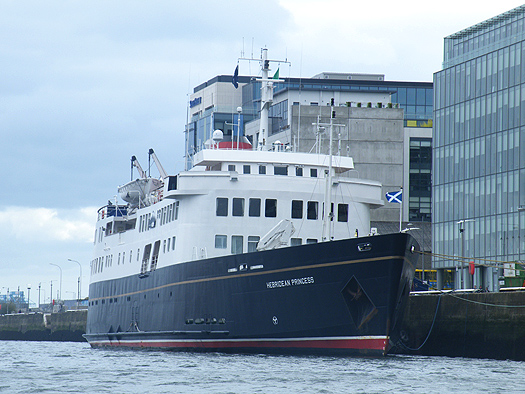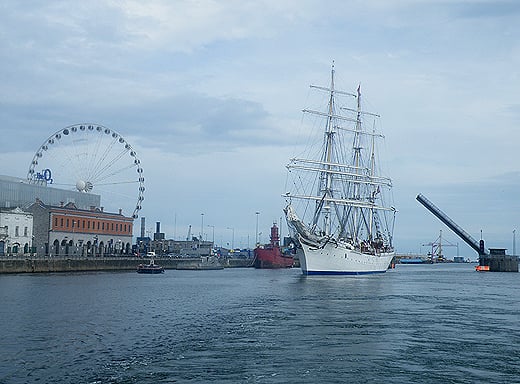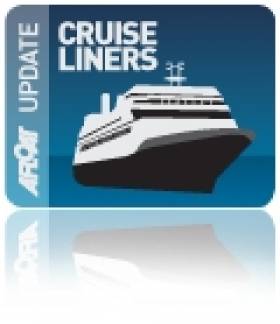Displaying items by tag: Dublin Docklands
It is only in recent years that larger vessels can berth at this stretch of the waterfront following the completion of several major construction projects over the last decade. From the building of the Convention Centre and the Samuel Beckett Bridge which involved using the dredger Hebble Sand (click HERE) during its construction process.
In addition the refurbishment of Spencer Dock sea-lock entrance that for many years was closed is now re-opened. The dock entrance featured in the start of the new television series 'Waterways'-The Royal Canal. Episode two is this Sunday on RTE 1 at 8.30pm.
Aside the 79m L.E. Roisin, the last large vessel to berth close to berth 16A was the French 58m tallship Belem, which was chartered by Alliance Francaise to celebrate their 50th anniversary in 2010 and for the inaugural French Hoist the Sail: Market Festival. The three-masted barque built in 1896 was once also owned by the Sir Arthur Ernest Guinness under the name of Fantôme II.
Situated between where L.E. Roisin is currently berthed and where the Belem had moored, is home to the 'resident' M.V. Cill Airne, a floating bar and restaurant dining venue at berth 16B. Another resident is the former lightship Kittiwake at berth 17B, though sited much further downstream at the end of North Wall Quay, opposite the O2 Arena and next to the East-Link Bridge.
There is a fourth resident, again berthed on the north quays, though the Jeanie Johnston unlike her counterparts is moored closer to the city-centre at Custom House Quay. Apart from yachts, leisure-craft and occasional private motor-yachts using the Dublin City Moorings, she is the only vessel to permanently occupy a berth between Samuel Beckett Bridge and the Sean O'Casey foot-bridge.
- inland waterways
- Dublin Port
- Dublin Docklands
- Royal Canal
- Jeanie Johnston
- naval service
- Custom House Quay
- Alliance Française
- Spencer Dock
- Sean O'Casey Bridge
- River Liffey
- Belem
- Sir John Rogersons Quay
- TallShips
- North Wall Quay
- Fantome II
- Dick Warner
- Dublin City Moorings
- Navy News
- O2 Arena
- EastLink bridge
- LE Roisin
- Sir Arthur Guinness
- National Convention Centre Dublin
- Samual Beckett Bridge
Queen Elizabeth's Chartered Cruiseship on Three-Day Visit to Dublin

Operated by Hebridean Island Cruises, the 5-star vessel which is for only 50 guests, has a reputation for exceptional service, fine dining and has a crew of 38. Accommodation is in thirty spacious, elegant and well-appointed cabins. On Princess Deck is located 'The Isle of Arran' (for deck plans click HERE) Suite which at 340sq ft is the largest and most expensive. The suite comprises a large separate dayroom, a spacious bedroom and a luxuriously equipped Victorian-style marble bathroom. In addition 10 cabins are designed especially for the single traveller. She has appeared in 1st place in UltraTravel Magazine's "10 Coolest Cruises"
Normally the Glasgow registered vessel operates throughout the Scottish highlands and islands, to lochs and remote mainland locations made accessible due to her small size. It is in these same waters that the Hebridean Princess has sailed in another guise as the humble car-ferry Columba (photos) for Caledonian MacBrayne. She was built in 1964 by Hall Russell, Aberdeen and served in this role until 1989 when she was sold and underwent an extensive conversion for the ultra-luxury cruise market.
Her three-day stay to Dublin is part of a Grand Celtic Cruise which started in Cardiff and which will include a call to Carlingford Lough tomorrow, followed by Strangford Lough, Bangor, Ballycastle, the Scottish isles of Jura and Crinan before disembarking in Oban, her home-port. The 10-night cruise inclusive of three-gala dinners cost €4,195 per person for a double cabin and €6,292 per person in a single-cabin.
A decade before Columba was launched, the Royal Yacht Britannia (5,682 tonnes) was commissioned in 1954. She was laid-down two years previously at John Brown & Co. Ltd, Clydebank and the year before she entered service she was launched by HM Queen Elizabeth II. For over four decades she served as the royal yacht until decommissioned in 1997. Her final foreign mission was to convey the last governor of Hong Kong and Prince of Wales from the former colony after its handover to China. She is now permanently moored as an exhibition ship in Edinburgh (Leith) for details click HERE.
Earlier this month Queen Elizabeth's namesake the 2010 built Cunard Line cruiseship Queen Elizabeth made her maiden Irish call to Dublin followed by Cork (Cobh). To read more on Dublin call click HERE and for Cork (Cobh) click HERE.
- Dublin Bay
- Dublin Port
- Dublin Docklands
- Cobh
- Cruise Liners
- Ports and Shipping
- Queen Elizabeth II
- Cruiseships
- Cunard Line
- The Convention Centre
- Cruise news
- Hebridean Princess
- Hebridean Princess Cruises
- Columba ferry
- Caledonian MacBrayne
- Hall Russell Shipyard
- Royal Yacht Britannia
- Hong Kong handover
- Prince of Wales
- Royal Yacht
Norwegian Tallship Opens to the Public in Dublin Docklands
The arrival of the largest and oldest Norwegian tallship the barque S/S Statsraad Lehmkuhl into Dublin Port yesterday made for an impressive sight, even without her sails set, writes Jehan Ashmore.



Her arrival marks nearly a year in advance to Dublin City welcoming the return of the Tall Ships Races, presented by Szczecin and organised by Sail Training International. The capital last hosted the event in 1998 and next year up to 100 tall ships are to sail into the capital which will be the final host port for four days between 23rd-26th August 2012.

Tall Ship S/S Statsraad Lehmkuh in Dublin Bay yesterday. Images: Iain White
The celebration of sail is expected to draw entrants from as far away as Chile, Mexico, Argentina, USA and European and Baltic countries including Italy and Norway will chart their course to Dublin. It is hoped that the event will attract over a million visitors to the city, topping the 500,000 spectators who thronged the Waterford quays during this year's tall ship race gathering.

Photo: Jehan Ashmore
Small Is Beautiful as Cruiseships Call Closer to Capital
Clipper Odyssey is an unusual caller to the capital as she normally operates cruises in the Pacific Ocean from New Zealand to the Russian Far-East. As for Le Diamant she is a frequent caller not just to Dublin but throughout Irish ports during the season.
The Bahama-flagged 110-passenger Clipper Odyssey is scheduled to depart this evening around 21.45hrs. She is bound for Dunmore East with an lunchtime arrival off the Waterford fishing port. Le Diamant with a capacity for up to 226 passengers follows with a departure set for 23.00hrs and she is bound for Fishguard Harbour, the gateway to the scenic Pembrokeshire Coast National Park.
Currently only small cruiseships can dock within the 'Docklands' quarter quays due to the limitations imposed on dimensions, as vessels transit through the East-Link toll lift-bridge which was built in 1984. The majority of cruiseships, which are considerably larger and can exceed over 100,000 gross tonnes, berth 2kms downriver mostly in Alexandra Basin and adjoining Ocean Pier.
There are proposals to build a dedicated cruise-terminal close to the East-Link bridge on the far side at North Wall Quay Extension, which would allow such larger vessels to dock. This would facilitate easier access for cruise tourists to visit the attractions of the city-centre and indeed the nearby amenities of the O2 Arena, which would be within walking distance of the proposed cruise terminal.
- Dublin Port
- Dublin Docklands
- Sir John Rogerson's Quay
- Cruise Liners
- Cruiseships
- Sean O'Casey Bridge
- River Liffey
- Cruise Liner news
- Samuel Beckett Bridge
- Cruisecallers
- Le Diamant cruiseship
- Clipper Odyssey cruiseship
- Dublin GasWorks
- Dublin Gasometer
- Ringsend Gasworks
- Pembrokeshire Coast National Park
- O2 Arena
Crosbie’s Café Lightship Plan Rejected
Dublin City Council told Crosbie that consent for the use of the campshires for the bar had not been agreed to by the board of the Dublin Dockland Development Authority (DDDA), which owns the quays, "and that said permission will not be forthcoming".
Crosbie had received a letter from the then chief executive officer of the DDDA Paul Maloney in December 2008 saying that the authority was willing to let the development go ahead, subject to consent from the authority's executive board.
This permission will not know be forthcoming but the authority does feel that the ship should be used as a bar on the Liffey itself rather than on the campshires.
The Kittiwake has laid idle since 2007 when the vessel was purchased from the Commissioners of Irish Lights. She was the second last lightship to serve in Irish waters. During the 1980's she and several other lightships were converted from manned operation into automatic light-floats or ALF's. To read more about the last Irish lightship ALF Gannet click HERE.
Up Close and Personal: New Boat Tours of Dublin Port
In addition to cruising this stretch of the River Liffey alongside the 'Docklands' quarter, the tour RIB boat will pass downriver through the East-Link toll bridge where visitors will get closer views of the variety of vessels and calling cruise liners from other ports throughout the world.
There will be five daily tours beginning at 10.00am, 12.00pm, 2.00pm, 4.00pm and 6.00pm.Tickets cost €15.00 for adults, €12.50 for students and the charge for senior citizens and children is €10.00.
In addition Sea Safari operate a 'River Liffey' only tour, a Dublin Bay 'North' and 'South' tours which visit Howth Head, Baily Lighthouse, Ireland's Eye and to Dalkey Island and Killiney Bay, where both bay tours provide a chance to spot local marine wildlife of seals, porpoises and sea birds.
- Rib
- Dublin Port
- Dublin Docklands
- Howth Head
- marine wildlife
- Cruise Liners
- Sea Safari Tours
- Dalkey Island
- Port of Dublin
- River Liffey
- Ports and Shipping News
- EastLink
- EastLink Toll Bridge
- Dublin Port news
- Baily Lighthouse
- Killiney Bay
- Seabirds
- Port of Dublin news
- RIBcraft
- M.V. Cill Airne
- Dublin Port cruise liners
- North Quay Wall Dublin
- Dublin Bay tours
- Ireland's Eye


































































